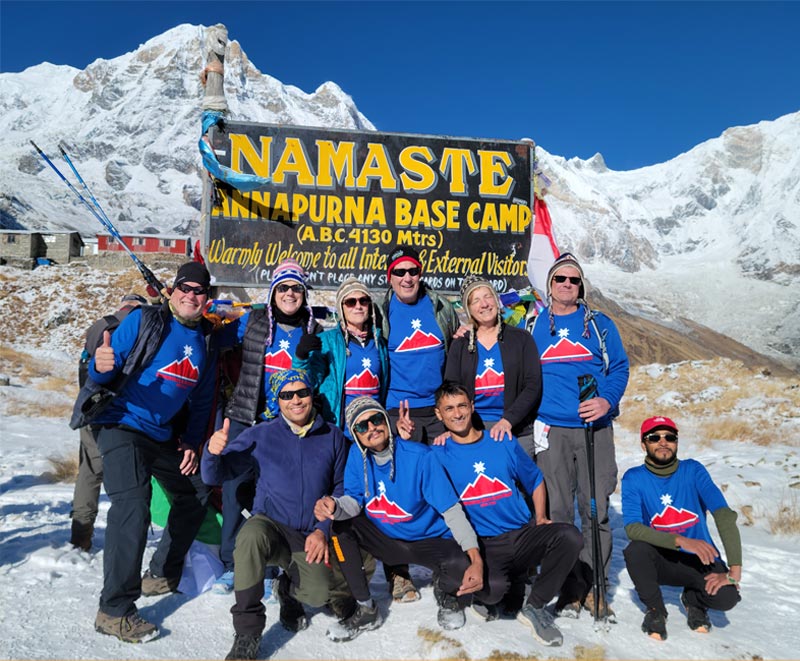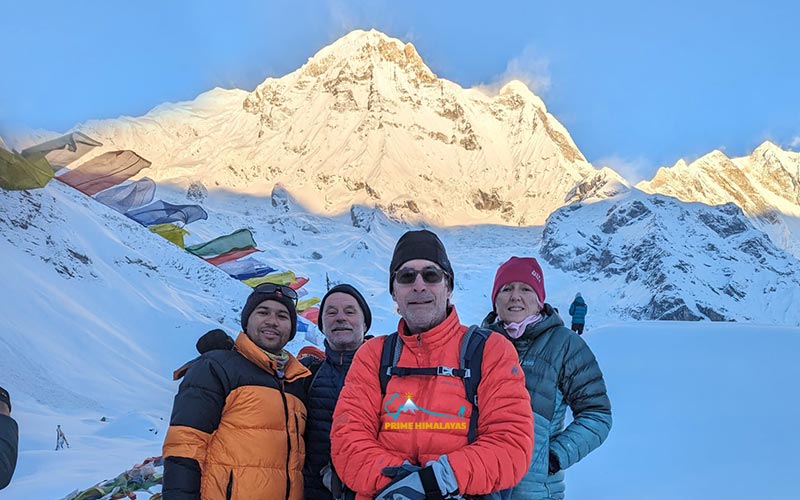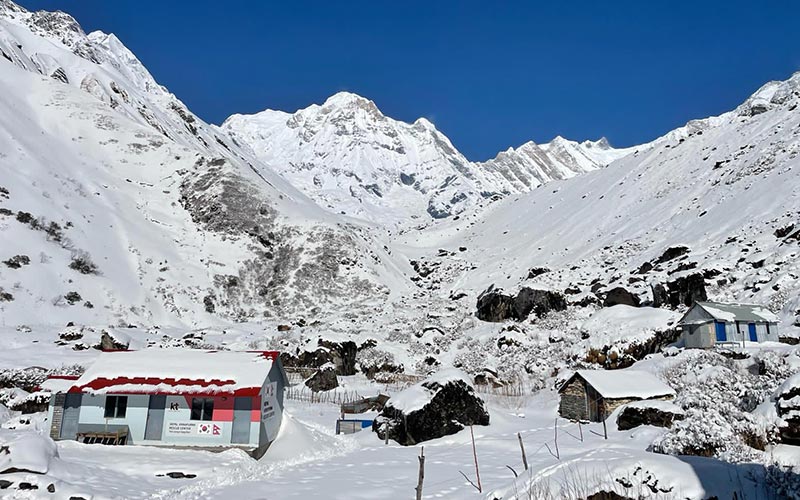The trek to Annapurna Base Camp is a once-in-a-lifetime opportunity. However, to embark on this demanding route, you must be aware of the weather conditions at Annapurna Base Camp. Generally, spring (March, April, and May) and autumn (September, October, and November) are considered the best times to visit. Among these months, April and October stand out as the prime months for trekking to Annapurna Base Camp.
If you’re planning an Annapurna Base Camp Helicopter tour, any month of the year can be ideal for exploration.
It’s essential for all trekkers to understand the climatic conditions, seasonal variations, visitor numbers each month, and the availability of guided tours in the Annapurna region. This knowledge helps overcome the challenges of the trek and aids in planning and preparation according to the weather demands. Additionally, understanding the weather patterns assists in determining the packing list for the Annapurna Base Camp trek.
Each trekker has their own weather preferences, influencing the timing of their trek. If you enjoy clear views and trek for photography, high seasons like spring and autumn are optimal. However, if you prefer uncrowded trails without the hustle and bustle of fellow trekkers, consider the off-season for the ABC trek.

Our guests are taking a group picture at Annapurna Base Camp during the trek.
Annapurna Base Camp Weather
The climatic condition of the Himalayas in Nepal is unpredictable and keeps on changing from time to time. Because of this reason, we can say that the Annapurna region is never really warm. While going for Annapurna Base Camp trek, you will be covering 210km as a round trip from Kathmandu. It means that you will be three levels higher from the beginning point when you reach the ending destination – ABC (4,130m).
Every time you gain height, you will feel a low temperature and a speedy wind around you. So, it is crucial for you to know about the minimum and maximum temperature of the Annapurna Base Camp trek in order to plan and prepare yourself for this trek.
| Months | Minimum Temperature (°C) | Maximum Temperature (°C) |
| January | -19°C | 7°C |
| February | -20°C | 6°C |
| March | -8°C | 4°C |
| April | -4°C | 8°C |
| May | 0°C | 14°C |
| June | 3°C | 16°C |
| July | 6°C | 18°C |
| August | 7°C | 19°C |
| September | 0°C | 20°C |
| October | -6°C | 16°C |
| November | -10°C | 11°C |
| December | -14°C | 9°C |
Note: Above presented data might not be exact as the weather of high Himalayas seem to surprise most of the trekkers by changing frequently. However, it is highly possible that the temperature of the Annapurna region will fluctuate around the above-mentioned data even if it changes quickly. Also, we would recommend you to study more about the weather of this region with the help of a local trekking agency and experienced guide before heading towards the trip.
Annapurna Base Camp Season
Remember different seasons have different weather, views, temperature, crowds, pros and cons to offer you. Because of this reason, you must have a deep insight about the Annapurna Base Camp Seasons before embarking on this trek. In some seasons, you will get to experience the bearable level of coldness and in some seasons, you will be facing extreme levels of chilliness. However, no matter which seasons you choose, you will always get something new to witness.

Same like the other part of Nepal, Annapurna Base Camp also has four kinds of seasons i.e., spring, summer/monsoon, autumn, and winter. These seasons take place in different months and have their own features regarding weather and temperature.
| Season | Month |
| Spring | March, April, and May |
| Monsoon/Summer | June, July, and August |
| Autumn | September, October, and November |
| Winter | December, January, and February |
Below we have described about the different seasons along with their pros and cons so that you can choose the perfect time for Annapurna Base Camp trek as per your climatic preferences and style.
1. Autumn Season (September – November)
Revolving around September, October, and November, autumn is regarded as the peak season for ABC trek. Because of the stable climatic pattern, temperate weather, low level of precipitation, cloudless skies etc., autumn is considered as the best season for trekking in Nepal. You will get to experience the fresh environment as the rainfall from the previous months wash away the dusty trail. Likewise, the vegetation and varied species of plants in the field and dense forest welcome you by smiling and spreading the fresh smell.
Among these months, October is likely to be preferred by trekkers as there is no rainfall and snowfall to block the views of peaks, local villages, glaciers etc. You can experience the warmer days and colder nights. September is the wettest month when there is the possibility of little rainfall. During November, little snowfall starts appearing and temperature starts to fall.
Besides all these advantages, there are also some disadvantages that you have to face while trekking during this season. It is hard to find accommodation services along with a guide and porter during this time. Similarly, the trail is crowded with trekkers and the base camp is filled with tents and climbers. So, if you are planning to trek in autumn, be ready to deal with these problems.
2. Spring Season (March – May)
Spring season falls in the months of March, April, and May and is regarded as one of the best seasons for Annapurna Base Camp trek. Warm temperature, clear visibility, little rainfall and no problematic snowfall tends to bring a greater number of trekkers to this region during this season. Similarly, the blooming Rhododendrons throughout the trail and vibrant environment make the trekking more memorable.
Among all these months, April is considered the best month because snow starts melting and skies become clear which provide the stunning view of snow-capped peaks. Likewise, there is no rainfall and snowfall during this month to interrupt the stunning panorama. May is much warmer than April as the monsoon starts to appear slowly and you can also observe the strange haze in the low altitude. During March, you can still face some sort of low snowfall and the temperature is little lower than April and May.

However, we all know that every good thing comes with a price. In the same way, trekking in spring also has some sort of drawbacks. During this time, it is very difficult to find the porter and guide for Annapurna Base Camp, low access to accommodation, extremely crowded trails, and excessive cost for basic facilities etc. But, if you want to get the best out of this region, then you need to make these trade-offs.
Despite having a vibrant and desirable environment, it is hard to trek during spring and autumn. It is even harder if you are planning for a solo trek to Annapurna Base Camp. However, with the help of experienced guides and porters, you can easily win over the Annapurna Base Camp difficulty. We, Prime Himalayas, assure you to provide the guide, porter and best possible accommodation facilities even during high season so plan your trek with us and make it wonderful.
Tips for Annapurna Base Camp Trek in Autumn & Spring
- Always plan your trip with local trekking agency as they are the one who can book the best possible accommodation in advance even when trekkers are extremely high in this region
- Avoid solo trek and hire guide for Annapurna Base Camp as they will help you in successfully completing your journey with less struggle
- Try to trek by following the alternative routes to Annapurna Base Camp trek
- Carry sleeping bag with you as you may not get the extra blankets in tea house because of the crowd
- Temperature in lower elevation is higher so carry the SPF 40+ sunscreen to avoid sunburn and allergy
- Be prepared physically and mentally to deal with the crowded trail throughout the trip
- Winter (December – February)
Winter falls in the months of December, January, and February and is regarded as the off season to trek to Annapurna Base Camp. This season receive the lower number of trekkers as compared to high season. Only those trekkers who want to enjoy the less crowded trail love to trek during these months. Even though it is regarded as off season, you can still observe the clear panorama of the surrounding areas and enjoy the photography and videography.
However, the problematic snowfall seems to make trekking a little difficult this time. Trails are blocked and many tea houses remain closed because of heavy snowfall. Moreover, the temperature falls down extremely and gives you a hard time in trekking and sleeping. Furthermore, you can’t experience crossing the high passes of the Himalayas region.
Tips for Annapurna Base Camp Trek in Winter
- Avoid independent trek to Annapurna Base Camp as much as you can
- Focus more on carrying the warm clothing like inner layers, down jacket, fleece jacket, wind/waterproof jacket, full collared shirts, fleece trekking trousers, warm long socks, toes/fingers warmer, beanie etc. Try to pack wisely and smartly.
- Carry the best sleeping bag to sleep warmly.
- Hire a local experienced guide so that you can get support throughout the trail.
- Prepare yourself to face the heavy snowfall and cold weather in the high altitude.
- Keep the slow pace while you are trekking in a snowy trail as it might be slippery.
- Always dress in the layer
4. Monsoon (June – August)
Monsoon is the rainy season and usually occurs in months of June, July, and August. With the start of June, this region slowly starts to receive the downpour and it goes on increasing in the following months July and August. Even though this season is warmer, most of the trekkers avoid trekking at this time because of slippery and muddy trails. Similarly, there is also a high chance of landslides and floods. Moreover, leeches and mosquitoes make the trek more challenging.
However, it doesn’t mean that trekking ABC is impossible at this time because it won’t rain all day long. If you don’t mind getting wet, then there are a number of benefits you can get while trekking. Rainfall washed away the dust and made the trail clean which will offer a splendid view of green landscapes. Also, trekkers are very low in number as a result you can witness and click the views freely without any rush.
Tips for Annapurna Base Camp Trek in Monsoon
- Pack mosquito repellent and table salt, as you will encounter a high number of leeches and mosquitoes.
- Always carry a waterproof backpack and make sure to pack waterproof clothing and boots.
- Plan your trek with a local trekking agency and hire an experienced guide to avoid adverse consequences on the trekking trail.
- Be physically and mentally prepared to face the rainfall and its consequences, such as slippery trails.
- Pack water purification tablets/droplets, as the water found on the trail might be contaminated.
If you are short in time and want to avoid the struggle of walking for the long hours, then you can choose the optional way i.e., Annapurna Base Camp Helicopter tour from Pokhara and can avoid possible problems that all these seasons have. Also, this Heli tour doesn’t demand for the best specific time, large packing list etc. as it can be completed within two hours.
The Annapurna Base Camp trek takes you to the foothills of two giant peaks – Annapurna and Machhapuchhre (Fishtail). Besides having the best time available, this trek can be done throughout the year. All you need is a guided tour, the right packing list, and proper preparation. The higher the elevation you gain, the higher the difficulty level, so you need to be physically and mentally prepared to face the challenges you might encounter on the trail.
Since it’s a high-altitude trek, we recommend trekking to Annapurna Base Camp with an experienced local trekking agency to increase your chances of success. Additionally, traveling with a guide who has first aid training would provide a hassle-free trekking experience. Plan your trip with us, and we’ll help you design the itinerary for your preferred months, allowing you to experience all the activities you’ve ever dreamt of.
How difficult is Annapurna Base Camp Trek?
Annapurna Base Camp trek is rated as moderately difficult trekking in Nepal which doesn’t demand any prior trekking skills. It can be the best trekking destination for both beginners and experienced trekkers as you will spend most of your time below 3,000m. However, it is not as simple as strolling around the city tour because it takes you above 4,000m. Moreover, high altitude brings extreme cold and chances of altitude sickness. Furthermore, you need to trek through the thousands of stairs.
But you can easily tackle the Annapurna Base Camp difficulty level if you prepare properly. Remember to practice hiking and take cardio and strength training before embarking on the trip. Also, hire a guide and porter for a better success rate.
How many days are required for Annapurna Base Camp Trek?
The Annapurna Base Camp trek covers a total distance of 67km from Pokhara. Typically, this trek takes 9-10 days to complete, starting and ending in Pokhara. However, the total duration depends entirely on the preferences of the trekkers. Based on our experience, we recommend allowing for an extra day as a buffer to accommodate unexpected weather conditions, as the climate in the Himalayan region is unpredictable. Similarly, consider extending your trek by adding more days so that you can fully appreciate the beauty of the Annapurna region without feeling rushed.
Can I reach Annapurna Base Camp trek without a guide?
Yes, if you want to enjoy hassle-free trekking and increase your chances of success, hiring a guide is the best way to reach Annapurna Base Camp. Without a guide, the likelihood of successfully reaching the base camp decreases. However, it is not mandatory to hire a guide for this trek. Based on research from many solo and guided tours, we personally recommend hiring a guide as they will accompany you throughout the trail, providing assistance and guidance. Doesn’t that sound safe and secure? Of course, it does!
